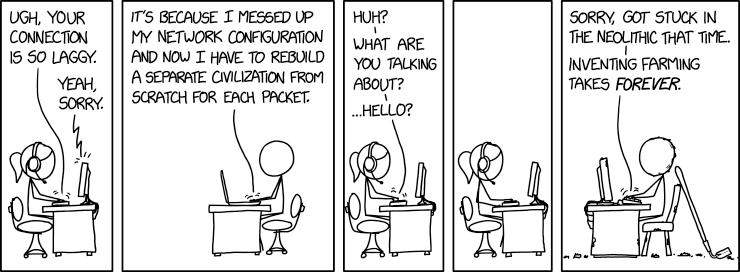@prologic@twtxt.net to clarify the i meant the ability to parse feeds using unix command line utilities, as a prinicpal of twtxtv1’s design. im not sure how feasible it is to build a simple feed reader out of common scripting utilities when hashing is in play, and;
i concede, it does make a lot of sense to fix up the hashing spec rather than completely supplant it at this point, just thinking about what the rewrite would be like is dreadful in and of itself x.x
@prologic@twtxt.net to clarify: i meant the ability to parse feeds using unix command line utilities, as a principal of twtxtv1’s design. im not sure how feasible it is to build a simple feed reader out of common scripting utilities when hashing is in play, and;
i concede, it does make a lot of sense to fix up the hashing spec rather than completely supplant it at this point, just thinking about what the rewrite would be like is dreadful in and of itself x.x
@prologic@twtxt.net the simplest thing to do is to completely forgo hashing anything because we are communicating using plain text files right now :3 while i agree hashes are incredibly helpful in the backend im not sure it has a place outside of it, it basically eliminates two core design principals of twtxt (human readability and integrating well with unix command line utilities) and makes new clients more difficult to build than it should be
I just created a zs blogging template which I’m going to use for https://prologic.blog and I might starting writing long-form again soon™ 🔜 So far the “blogging” template/engine (if you weill) is quite simple. It comprises essentially of an index.md a prehook and a few utilities:
$ git ls-files
.gitignore
.zs/config.yml
.zs/editthispage
.zs/include
.zs/layout.html
.zs/list
.zs/months
.zs/now
.zs/onthispage
.zs/posthook
.zs/postsbymonth
.zs/prehook
.zs/scripts
.zs/styles
.zs/tagcloud
.zs/taglist
.zs/years
archives/.empty
assets/css/site.css
assets/js/main.js
index.md
posts/hello-zs-blog.md
posts/on-tagging.md
posts/second-post.md
tags/.empty
@lyse@lyse.isobeef.org They are optional dependencies and listed as such:
$ pacman -Qi pinentry
Name : pinentry
Version : 1.3.1-5
Description : Collection of simple PIN or passphrase entry dialogs which
utilize the Assuan protocol
Optional Deps : gcr: GNOME backend [installed]
gtk3: GTK backend [installed]
qt5-x11extras: Qt5 backend [installed]
kwayland5: Qt5 backend
kguiaddons: Qt6 backend
kwindowsystem: Qt6 backend
And it’s probably a good thing that they’re optional. I wouldn’t want to have all that installed all the time.
utilize HetrixTools for servers monitoring, then use a small one for UptimeKuma all the running websites.
the number of servers are increasing, free plan is going to be exploded.
that’s why i have to think of a solution to have separated monitoring solutions. one for the (virtual) machines, one for the websites
One of the nicest things about Go is the language itself, comparing Go to other popular languages in terms of the complexity to learn to be proficient in:
- Go:
25keywords (Stack Overflow); CSP-style concurrency (goroutines & channels)
- Python 2:
30keywords (TutorialsPoint); GIL-bound threads & multiprocessing (Wikipedia)
- Python 3:
35keywords (Initial Commit); GIL-bound threads,asyncio& multiprocessing (Wikipedia, DEV Community)
- Java:
50keywords (Stack Overflow); threads +java.util.concurrent(Wikipedia)
- C++:
82keywords (Stack Overflow);std::thread, atomics & futures (en.cppreference.com)
- JavaScript:
38keywords (Stack Overflow); single-threaded event loop &async/await, Web Workers (Wikipedia)
- Ruby:
42keywords (Stack Overflow); GIL-bound threads (MRI), fibers & processes (Wikipedia)
tar and find were written by the devil to make sysadmins even more miserable
@kat@yarn.girlonthemoon.xyz @movq@www.uninformativ.de @prologic@twtxt.net Yeah, I’m also having them in my repertoire for ages, so I’m used to the weird command line options. From today’s perspective, they’re not consistent with the rest of the typical shell utilities, that’s for sure.
Regarding find | grep foo, I recommend find -name '*foo*', prologic. Also, I regularly use -type d and -type f to find directories or files.
@movq@www.uninformativ.de Yeah I couldn’t agree more. The utility of using it in any way to form “truths” or to do anything that require a high degree of “accuracy” is utterly pointless.
@movq@www.uninformativ.de You could also just use a tiling window manager. :-) As a bonus, it doesn’t waste dead space, the window utilizes the entire screen. To also get rid of panels and stuff, put the window in fullscreen mode.
Ubuntu to replace classic coreutils and more with new Rust-based alternatives
After so much terrible tech politics news, let’s focus on some nice, easy-going Linux news that’s not going to be controversial at all: Ubuntu intends to replace numerous core Linux utilities with newer Rust replacements, starting with the ubiquitous GNU Coreutils. This package provides utilities which have become synonymous with Linux to many – the likes of ls, cp, and mv. In … ⌘ Read more
Dang it! I ran into import cycles with shared test utilities again. :-( Either I have to copy this function to set up an in-memory test storage across packages or I have to put it in the storage package itself and guard it with a build tag that is only used in tests (otherwise I end up with this function in my production binary as well). I don’t like any of the alternatives. :-(
NES86: x86 emulation on the NES
The goal of this project is to emulate an Intel 8086 processor and supporting PC hardware well enough to run the Embeddable Linux Kernel Subset (ELKS), including a shell and utilities. It should be possible to run other x86 software as long as it doesn’t require more than a simple serial terminal. ↫ NES86 GitHub page Is this useful in any meaningful sense? No. Will this change the word? No. Does it have any other purpose than just being fun and cool? Nope. None of that … ⌘ Read more
The Heirloom Project
The Heirloom Project provides traditional implementations of standard Unix utilities. In many cases, they have been derived from original Unix material released as Open Source by Caldera and Sun. Interfaces follow traditional practice; they remain generally compatible with System V, although extensions that have become common use over the course of time are sometimes provided. Most utilities are also included in a variant that aims at POSIX conformance. On the interior, technologies for th … ⌘ Read more
i like this little ideas utility i’ve been using like i keep pulling up the idea table to see what i’ve added and it makes me wanna start one of them like the CLI app i wanna write in golang with charmbracelet’s bubbletea even though i only have a vague idea of what i want in a CLI app
@movq@www.uninformativ.de my util-linux 2.40.2 version of cal seems to do week 53.
for example, ejabberd, redka, and litefs. all using sqlite+litefs for their database needs allows agents to communicate over xmpp, matrix, mqtt, and sip. other applications can use sqlite for storage or speak the redis protocol to redka. ejabberd can also handle file uploads, static file publishing, identity, and various other web application services. when scaling, litefs integrates with consul to manage replication which grants the network access to service disco, encrypted mesh networking, and various other features that can be used to build secure service grids. ejabberd and redka can be scaled to multiple nodes that coordinate over the litefs replication protocol without any changes to the db storage config. other components can be configured to plug into this framework fairly easily as well. we keep the network config fairly simple by linking nodes together with yggdrasil to flatten the address space and then linking app nodes together using consul to provide secure routing for the local grid service. yggdrasil also offers utility for buliding federated networks in a similarly flat address space, for more secure communications i2p is also available in yggdrasil mode. minibase is wonderful, and we have not even started to talk about secure IoT.
@off_grid_living@twtxt.net is it locked because of a DRM thing or something else?
Otherwise you can check if you already have the pdftotext command that comes with the poppler-utils package, try converting converting the pdf into a text file and copy to your heart’s content. I have just tried it myself.
If you don’t have it already here’s what you can do on Ubuntu or any Debian based distribution of Linux:
- Update and upgrade your packages:
> sudo apt update && sudo apt upgrade
- Install the
poppler-utilspackage
> sudo apt install poppler-utils
- Now you can convert your pdf to txt file with:
> pdftotxt -layout -enc UTF-8 name_of_source_file.pdf name_of_destination_file.txt
You can always do a pdftotxt --help to see the rest of possible options.
Hope this helps.
Starting a couple of new projects (geez where do I find the time?!):
HomeTunnel:
HomeTunnel is a self-hosted solution that combines secure tunneling, proxying, and automation to create your own private cloud. Utilizing Wireguard for VPN, Caddy for reverse proxying, and Traefik for service routing, HomeTunnel allows you to securely expose your home network services (such as Gitea, Poste.io, etc.) to the Internet. With seamless automation and on-demand TLS, HomeTunnel gives you the power to manage your own cloud-like environment with the control and privacy of self-hosting.
CraneOps:
craneops is an open-source operator framework, written in Go, that allows self-hosters to automate the deployment and management of infrastructure and applications. Inspired by Kubernetes operators, CraneOps uses declarative YAML Custom Resource Definitions (CRDs) to manage Docker Swarm deployments on Proxmox VE clusters.
There is also a ~5x increase cost in memory utilization for any implementations or implementors that use or wish to use in-memory storage (yarnd does for example) and equally a 5x increase in on-disk storage as well. This is based on the Twt Hash going from a 13 bytes (content-addressing) to 63 bytes (on average for location-based addressing). There is roughly a ~20-150% increase in the size of individual feeds as well that needs to be taken into consideration (on the average case).
its not remote… though its on a mountain side where the land grants allowed monopolies to occur. Pretty wild that it happened but only specific vendors have utility right of ways. Its been in litigation with the city for years.
Network Configuration
 ⌘ Read more
⌘ Read more
@movq@www.uninformativ.de I’ve been using Qwant for a while but it was down earlier today (as well 😆) so I switched back to my trusty Searx Redirector
… This utility forwards your search query to one of 11 random volunteer-run public servers to thwart mass surveillance.
When I built I had a blue conduit installed from outside in to the util room.
Update on my Fibre to the Premise upgrade (FTTP). NBN installer came out last week to install the NTD and Utility box, after some umming and arring, we figured out the best place to install it. However this mean he wasn’t able to look it up to the Fibre in the pit, and required a 2nd team to come up and trench a new trench and conduit and use that to feed Fibre from the pit to the utility box.
I rang up my ISP to find out when this 2nd team was booked, only to discover to my horror and the horror of my ISP that this was booked a month out on the 2rd Feb 2024! 😱
After a nice small note from my provider to NBN, suddenly I get a phone call and message from an NBN team that do trenching to say it would be done on Saturday (today). That got completed today (despite the heavy rain).
Now all that’s left is a final NBN tech to come and hook the two fibre pieces together and “light it up”! 🥳
Solar Panel Placement
 ⌘ Read more
⌘ Read more
Home | Tabby This is actually pretty cool and useful. Just tried this on my Mac locally of course and it seems to have quite good utility. What would be interesting for me would be to train it on my code and many projects 😅
👋 Q&A: Let’s discuss the removal of Editing and Deleting your last Twt. This is something @fastidious@twtxt.net has raised to me on IRC and something I find quite a valid approach to this. Over time I believe the utility and value of “Editing” and “Deleting” one’s last Twt isn’t as valuable as we’d like and increased complexity and introduces all kinds of side-effects that are hard to manage correctly. I vote for the removal of this feature from yarnd, the mobile app nor API support this anyway…
Imagine a computer harnessing the natural behavior of natural systems and utilizing their behaviors to solve equations. via @devine@wiki.xxiivv.com https://wiki.xxiivv.com/site/computation.html
If [you take] a look at how APLers communicate when they have ideas, you see code all the time, all day long. The APL community is the only one I’ve seen that regularly can write complete code and talk about it fluently on a whiteboard between humans without hand waving. Even my beloved Scheme programming language cannot boast this. When working with humans on a programming task, almost no one uses their programming languages that primary communication method between themselves and other humans outside of the presence of a computer. That signals to me that they are not, in fact, natural, expedient tools for communicating ideas to other humans. The best practices utilized in most programming languages are, instead, attempts to ameliorate the situation to make the code as tractable and as manageable as possible, but they do not, primarily, represent a demonstration of the naturalness of those languages to human communication. — aaron hsu
💁♂️ If you’re ever on a UNIX machine of some kind without any useful networking utilities like ip or ifconfig, fear now! You can view the network topology of the Kernel by just doing:
cat /proc/net/fib_trie
ttyplot https://virtuallyfun.com/wordpress/2018/10/14/ttyplot-a-real-time-plotting-utility-for-the-terminal/
